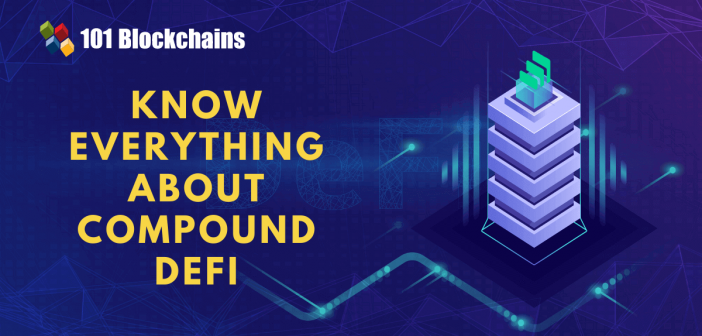Are you a finance professional, aspiring to know about Compound? Here we bring a detailed guide about Compound protocol, how does it work, and Compound DeFi connection. Let’s dive in.
The evolution of blockchain and cryptocurrencies has created a completely new ecosystem with many investors, traders, and enthusiasts. The ecosystem involves the regular exchange of multiple blockchain assets. On the other hand, the sophistication of financial markets has not evolved as expected. Participants have limited capabilities for trading the time value of assets.
Interest rates serve an important role in addressing the differences between people with additional assets, which they could not use, and people without assets. This is where the Compound protocol comes in. The following discussion offers you a detailed overview of Compound and how it is an integral part of the emerging DeFi ecosystem.
Build your identity as a certified blockchain expert with 101 Blockchains’ Blockchain Certifications designed to provide enhanced career prospects.
The Need for Compound Finance
Before moving to the Compound DeFi connection, it is important to reflect on the origins or background of Compound. Blockchain-based assets encounter two major setbacks in present times such as,
- The highly restricted borrowing mechanisms, responsible for inaccurate pricing of assets.
- The negative yield of blockchain assets is also an important concern stemming from notable storage costs and risks, without the natural interest rates for offsetting the costs. The lack of incentives for the asset holdings generally leads to higher volatility of blockchain assets.
Centralized exchanges offer the facility for trading blockchain assets with in-built borrowing markets in the exchange. However, centralized exchanges bring the element of trust alongside restrictions for specific customer groups. On the other hand, peer-to-peer protocols can provide collateralized and uncollateralized loans among market participants. However, decentralization could lead to prominent costs and conflicts for users. Therefore, the Compound blockchain emerged as a solution for enabling frictionless borrowing and lending of Ethereum tokens.
Want to explore in-depth about DeFi protocol and its use cases? Enroll in Decentralized Finance (Defi) Course- Intermediate Level Course Now!
The Compound DeFi Connection
With a brief understanding of DeFi, you can find out how the Compound protocol aligns with the larger crypto landscape. Cryptocurrencies serve as decentralized money when you have to make payments, as you can notice with Bitcoin. One individual can pay Bitcoin to another individual without dealing with any bank or financial service intermediaries.
On the contrary, the users have to go through the Bitcoin network, which includes a decentralized network comprising independent nodes for verifying and validating transactions. However, the scope of financial services extends well beyond payments and includes other services like insurance, checking and savings, taxes and accounting, and borrowing and lending. DeFi or decentralized finance practically focuses on the decentralization of all financial services through crypto and blockchain protocols.
Ethereum serves as the primary foundation of the existing DeFi landscape. It is a decentralized blockchain network that offers smart contract functionalities for developing other decentralized apps with their native cryptocurrencies. The Compound protocol basically focuses on the decentralization of the financial services of crypto borrowing and lending. So, what is the role of Compound in the domain of DeFi?
Want to know more about DeFi? Enroll Now: Introduction to DeFi Course
Definition of Compound
Compound or Compound Finance is basically a decentralized marketplace for crypto investors which offers functionalities for lending and borrowing digital assets. Compound crypto is basically a decentralized protocol developed over a blockchain. Users have the privilege of dictating governance precedents for the Compound protocol with the help of the COMP token. From a technical perspective, you can think of Compound as a system of smart contracts developed on Ethereum with open accessibility. The protocol emphasizes enabling borrowers to take loans and lenders to offer loans through locking their crypto assets in the protocol.
Interestingly, the supply and demand of each crypto asset help in determining the interest rates that borrowers and lenders could pay and receive. The mining of each block leads to generation of interest rates. Furthermore, borrowers can pay back the loans at any time alongside the flexibility for withdrawing locked assets.
Unique Highlights of Compound
The next important concern in understanding the answer for ‘What is Compound in DeFi?’ points towards the uniqueness of Compound. What makes it so special in DeFi? The compound may look like just another decentralized lending protocol that leverages crypto assets as collateral for borrowing additional crypto assets. However, Compound has a unique highlight in the fact that it enables tokenization of assets locked in the system by using COMP tokens.
COMP tokens or cTokens are just ERC-20 tokens providing representation of a user’s funds in the Compound blockchain. When you put ETH or any other ERC-20 token such as USDC, you would get the equivalent amount of cTokens. The tokens would then automatically earn interest for you. Users can choose to redeem their cTokens for normal tokens alongside the interest paid in the tokens. It is also important to note that every asset has a specific market and the supply or demand of the asset in the market plays a crucial role in determining the interest rates.
Working of Compound
After a clear understanding of ‘what is Compound in DeFi?’ you would definitely look for information on how it works. As you have noticed, Compound is basically a decentralized borrowing and lending platform based on Ethereum. So, how does one borrow crypto from the Compound blockchain or earn interest on their crypto with it? Let us take a deeper look at how Compound Finance works for lending and borrowing services.
-
Crypto Lending in Compound
The Compound protocol supports lending and borrowing of a particular selection of cryptocurrencies. As of now, Compound supports the following crypto tokens.
- Ether (ETH)
- USD Coin (USDC)
- Wrapped BTC (WBTC)
- Sai (SAI)
- Dai (DAI)
- Basic Attention Token (BAT)
- Tether (USDT)
- Ox (ZRX)
- Augur (REP)
Any individual with these crypto-assets could easily lend and borrow crypto on Compound without investing time, money, and effort in dealing with intermediaries. If you own these cryptocurrencies, then you could deposit, lock, lend or send any amount in the Compound protocol. When you lock your crypto in the Compound protocol, it is similar to depositing money in a savings account. However, you would not be sending your crypto to a bank. On the contrary, your crypto goes to the Compound wallet. Subsequently, you can earn interest on your crypto just like you would get interested in your savings account deposits in banks.
The interest earned on your crypto comes in denominations of the same token you have locked in the Compound blockchain. For example, if you have locked USDC in the Compound wallet, you would earn interest in USDC. When you send crypto to Compound Finance, it goes into a giant pool of similar tokens in a Compound protocol smart contract. Where does the pool come from? Many other people all over the world would also lock in their crypto assets in Compound, thereby leading to the creation of the pools.
Want to become a Cryptocurrency expert? Enroll Now in Cryptocurrency Fundamentals Course
-
Crypto Borrowing in Compound
The other significant application of Compound in DeFi refers to borrowing. Once you have locked in a specific amount of crypto in Compound, you can have the privilege of borrowing against it. The interesting aspect about Compound is that you don’t need a credit check. Therefore, any individual in any location of the world with crypto assets could have the privilege of borrowing from Compound.
However, Compound verifies the quality of the asset for determining how much an individual could borrow against the asset. For example, if you lock in 1000 BAT priced at $500 in Compound and the protocol has set a 50% borrowing limit for BAT, you can borrow any other crypto worth $250 supported by Compound protocol. Furthermore, you would also have to pay interest on the borrowed crypto just like you pay interest to banks for the loans you have borrowed.
Want to learn about more risks in DeFi? Check out our guide to risks in DeFi and how you can manage them right now!
Interest Rates in Compound Finance
As you can notice how lending and borrowing works on Compound with the help of Compound token or cTokens. However, the common element in the lending and borrowing applications of Compound refers to the interest rates. In the case of lending, you would earn interest, and in the case of borrowing, you have to pay interest. Let us take a look at how the interest rates for borrowing and lending vary in the case of Compound.
Irrespective of borrowing or lending functions on Compound blockchain, users have to lock their crypto assets in Compound. Upon locking your crypto in Compound, you would get the equivalent amount of Compound token or cTokens. The cTokens provide representation for balance of your crypto assets. cTokens are basically ERC-20 tokens on Ethereum and serve exceptional value of innovation in a blockchain-based crypto money market.
You can transfer, trade, or programmatically integrate cTokens in other dApps in the DeFi landscape, just like other Ethereum tokens. At the same time, you would also earn or pay interest depending on whether you lend or borrow on Compound. Users can control the Compound token with their public and private keys, like any other digital asset on Ethereum blockchain.
The interest rates in Compound DeFi are basically a function of the liquidity of crypto in each market. Therefore, it can vary in real-time according to the supply and demand of the asset for aligning with existing market conditions. The interest rates on Compound are evident as annual interest rates, which accrue with every instance of mining Ethereum blocks. The value of cTokens increases by a margin of 1/2102400 of the quoted annual interest every 15 seconds.
Want to learn the basic and advanced concepts of Ethereum? Enroll Now: Ethereum Development Fundamentals
Working of Compound Liquidity Pools
Another critical highlight in understanding how Compound Finance works would refer to the working of Compound liquidity pools. When you lock large pools of crypto in Compound, the interest rates become low as there is plenty of crypto for borrowing. However, you wouldn’t get favorable interest rates by adding to the concerned crypto pool in Compound protocol.
However, if the pool is small, you could earn more with higher interest rates. Fluctuation in the interest rates could ensure incentives for lending new crypto assets to smaller pools for earning higher interest rates. At the same time, you can repay borrowed crypto into small pools while borrowing from large pools for lesser interest.
Whether you borrow or lend from Compound, you have to lock in your crypto assets. In the case of borrowing, you must lock an amount of crypto in Compound, which has more worth than the amount you intend to borrow. As a result, the loan you borrow from Compound blockchain is over collateralized.
Furthermore, you should also notice that the crypto deposited as collateral has higher volatility and could experience value drops. When the value becomes closer to the value of crypto borrowed, a Compound token or cToken smart contract closes the position. Such a process is referred to as liquidation, where you can get the amount you have borrowed and lose collateral.
The Role of COMP Token
The final aspect in understanding Compound DeFi would obviously point towards the governance implications. Compound Finance leverages COMP as its governance token, with a specific amount distributed among lenders and borrowers on Compound regularly. With every Ethereum block mining process, COMP distributions are an inevitable occurrence.
The distribution of COMP token is directly proportional to interest accumulated with each asset. Holders of COMP token can offer proposals and make votes on modifications for the protocol. At the same time, COMP also enables privileges for monitoring the treasury and reserves of the Compound protocol. Each COMP token provides representation for one vote, and it could be delegated to other parties on your behalf.
The governance proposals in Compound are generally available as executable code with a three-day voting timeframe. Community approval for governance changes in the protocol could take around two days to come into effect. The native COMP governance token offers the value of blockchain for lending and borrowing applications in a massively expanding DeFi ecosystem.
Final Words
As you can see, the Compound protocol is basically another DeFi solution that helps users in lending and borrowing crypto. Based on Ethereum, Compound leverages the use of smart contracts functionality for lending and borrowing transactions. Users have to lock a specific amount of crypto in Compound Finance, and they could lend or borrow crypto assets.
However, Compound offers support for a selected assortment of cryptocurrencies. From a broader perspective, the Compound DeFi protocol could simplify access and control over the money you earn and save. Start exploring more about Compound by understanding the concepts of Decentralized Finance (DeFi) now!
*Disclaimer: The article should not be taken as, and is not intended to provide any investment advice. Claims made in this article do not constitute investment advice and should not be taken as such. 101 Blockchains shall not be responsible for any loss sustained by any person who relies on this article. Do your own research!






